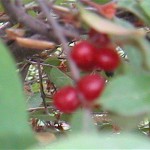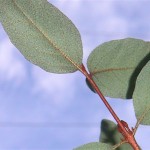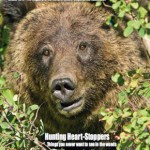by Catherine Haug
(Photos by C.Haug)
I have a section of my yard that has never been landscaped, and is full of native shrubs and flowers. The other day I noticed a shrub with berries that I had not noted before (though by its size, it has been there for many years). With the help of Brett T., it has been identified as Shepherdia canadensis or Canadian buffaloberry, which is also known as soapberry.
The Chinook name is Soopolallie (soapberry), and natives of the Pacific Northwest made a summertime sweet concoction called sxusem. From Wikipedia (2):
“The bitter berries are not eaten directly but rather processed as sxusem (‘sxushem’) or ‘Indian ice-cream’. Branches bearing fruit are hit with a stick and only the very ripe fruits that fall off are collected. A clean mat or tarpaulin is placed below the bush for collection. The berries are later placed into a great bowl that is absolutely free of oil or fat and are mixed with some sweet fruit such as raspberries. The mixture of berries is crushed and vigorously beaten in the manner of whipping cream in order to raise the typical foam of the sxusem confection.
Sxusem has an agreeable blend of sweet and somewhat bitter tastes, possibly comparable to that encountered in sweetened coffee. The substance is believed the First Nations peoples who prepare it to have many healthful properties, but the saponin chemicals making up the foam may also cause gastrointestinal irritation if consumed greatly.”
A Canadian ecosystem recovery website, GOERT (3), adds this about sxusem:
“Berries [were] whipped to form “Indian ice cream” which was sweetened with salal berries, camas bulbs or hemlock cambium.”
Recognizing this Shrub
There are both male and female shrubs; the male does not produce fruit. They can grow to 5 feet tall or so on a woody stem. The deciduous leaves are oval, dark to medium green in color, and arranged in simple, opposite manner (not alternating). The underside of the leaves is a lighter grey-green from tiny silvery hairs, with rusty colored spots or scales.
It’s yellow flowers are inconspicuous and not notable.
The ripe berries are orange to red, slightly translucent, and about 1/4 inch in diameter. If you crush them, they will make a soapy foam. They are not sweet and in fact are bitter, but many animals eat them, including deer and bear.
See E-Flora BC for more information on recognizing buffaloberry, with photos, sketches and more. (5)
Growing this Shrub
Buffaloberry is drought tolerant, and has nitrogen-fixing ability. It can be propagated by seed or cuttings. See the GOERT website for more information (3).
Cautionary note:
Photo, right (used by Rural Montana Maggzine, October 2010 issue) by Steve Akre; see outwestphoto.net. Note that buffaloberry is another name for soapberry.
MountainNature.com (4) provides this cautionary note about this plant:
“If you learn to identify only one plant in the Canadian Rockies, make it this one. The new millennium brought with it a high incidence of bear encounters throughout the eastern slopes, all because of a bumper crop of buffaloberry. Once the berries ripen, this becomes the most important plant for bears within the northern Rockies. Any trail with an abundance of buffaloberries will also have bears.
Try to avoid heavily berried trails in August and September, or at the very least make a lot of noise while hiking in such locales. Remember, an adult grizzly may eat upwards of 200,000 buffaloberries every day during this period. They may also get so engrossed in feeding that they do not hear you approach. Make sure you make lots of noise.”
Sources
- Photos by C. Haug
- Wikipedia: en.wikipedia.org/wiki/Indian_ice-cream
- Goert.ca: www.goert.ca/propagation_guidelines/shrubs/shepherdia_canadensis
- Mountain Nature.com: www.mountainnature.com/Plants/PlantsLatinNameResult.asp?ID=69
- E-Flora BC: linnet.geog.ubc.ca/Atlas/Atlas.aspx?sciname=Shepherdia%20canadensis
- Steve Akre’s website (Griz photo): outwestphoto.net


